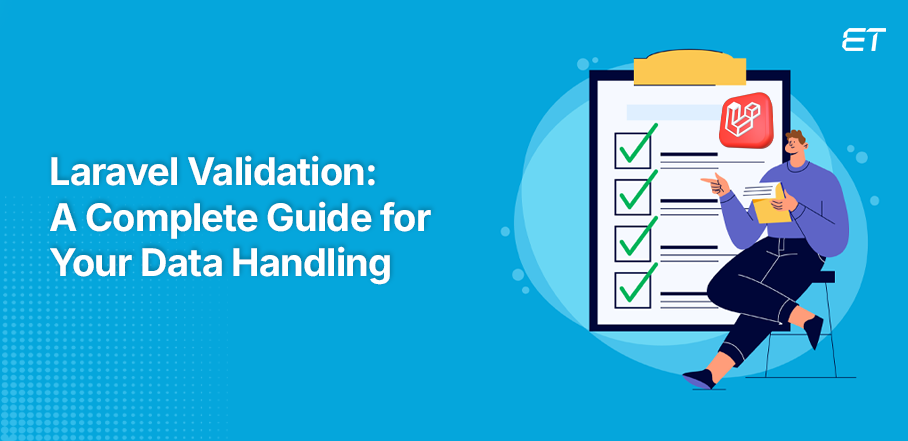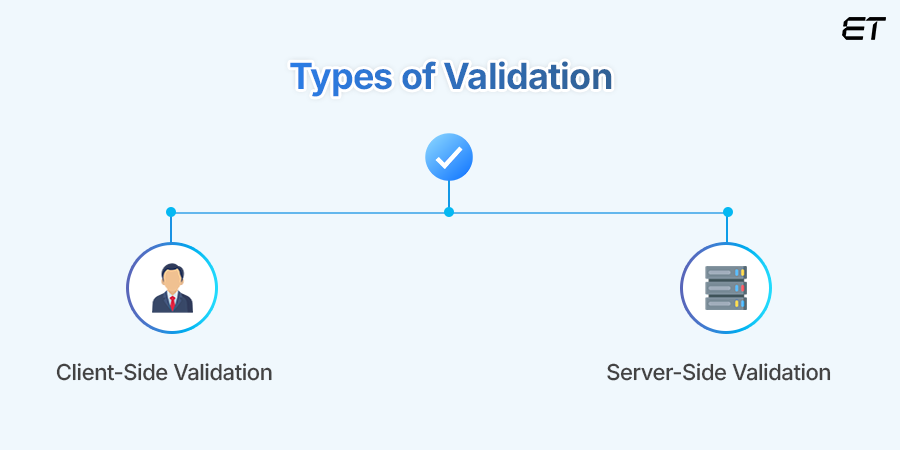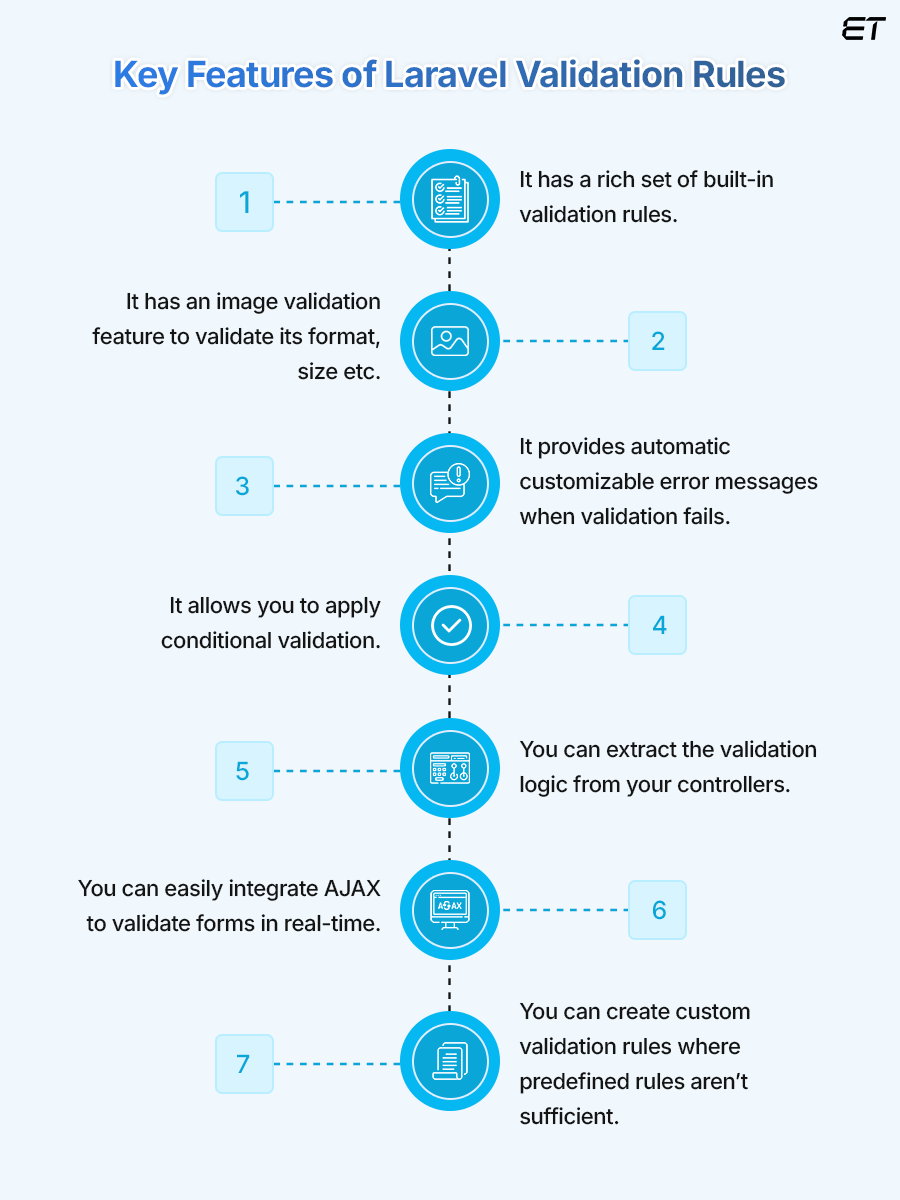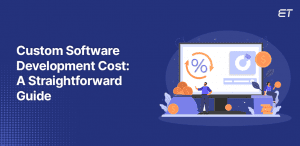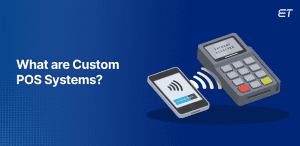Data security has become more critical than ever. So, it is unquestionable that you must ensure the information flowing through your applications is accurate and safe. Whether you’re building a small-scale web application or handling complex enterprise-level data, clean and validated data is the backbone of any successful project.
Nearly 30% of all data stored by businesses is either inaccurate or incomplete. That’s where Laravel validation comes into play — it is an essential tool for maintaining the integrity, security, and reliability of your applications.
In this guide, we’ll dive deep into Laravel’s validation features and explore how they can help your business manage data with confidence and ease. Ready to make your data fool proof? Let’s get started!
What is Laravel Validation?
| Laravel, a popular PHP framework, offers a robust and flexible validation system that simplifies the process of validating input data. It not only ensures that data entering your system is correct but also protects your application from potential security threats. Whether you’re working with forms, APIs, or complex data structures, Laravel provides you with all the tools you need to handle data efficiently and securely. |
Why is Data Validation Important for Your Business?
Data validation is critical for any business that deals with user inputs, transactions, or sensitive data. You can think of it as a gatekeeper that ensures the integrity, accuracy, and security of the data flowing into your systems. Without proper validation, you’re likely to run the risk of processing incorrect or malicious data. This could lead your business to operational inefficiencies, security breaches, and even financial loss.
Therefore, accurate data is essential for you to make informed and correct decisions. For instance, if you run an e-commerce platform, incorrect customer addresses or payment details can lead to delivery errors, failed transactions, or customer dissatisfaction. Such issues not only damage your reputation but also increase your operational costs. You can minimize these errors by ensuring that the data being processed is correct. This will assist you in improving your overall operational efficiency.
Additionally, it also assists you in preventing issues like:
- SQL Injection Attacks: These are where malicious users can exploit unvalidated data and insert harmful code into your database, thereby putting your and your users’ privacy at stake.
- Inconsistent User Input: Validating data assists you in ensuring uniform data across your platform, which creates smoother processes and fewer errors.
- Data Integrity: By validating input data, Laravel helps ensure that all incoming data aligns with the structure and rules of your database, keeping things clean.
Looking for Laravel solutions that scale? Unlock tailored, high-performance web apps built by our expert developers today and discover the difference yourself!
Types of Validation
Validation is a crucial aspect of any web application, and it can be categorized into two main types: client-side validation and server-side validation.
Client-Side Validation
Client-side validation is the process of checking the input data on the client-side, i.e., on the user’s browser. This type of validation is typically performed using JavaScript and is used to provide immediate feedback to the user about any errors or issues with their input. For instance, if a user forgets to fill out a required field or enters an invalid email address, client-side validation can instantly alert them to correct the mistake. This immediate feedback enhances the user experience by allowing users to rectify errors on the spot.
However, client-side validation is not foolproof. Since it runs on the user’s browser, it can be easily bypassed by malicious users who disable JavaScript or manipulate the client-side code. Therefore, while client-side validation is useful for improving user experience, it should not be relied upon as the sole method of validation.
Server-Side Validation
Server-side validation, on the other hand, is the process of checking the input data on the server-side, i.e., on the web server. This type of validation is typically performed using a programming language, such as PHP, and is used to ensure that the input data meets the required criteria before it is processed or stored. Server-side validation is more secure than client-side validation because it cannot be bypassed by malicious users. It ensures that all input data is thoroughly checked, regardless of any client-side manipulations.
For example, when a user submits a form, the server-side validation will check the data against predefined rules, such as ensuring that an email address is in the correct format or that a username is unique in the database. This comprehensive validation process helps prevent security vulnerabilities, such as SQL injection attacks, and ensures that the data stored in the database is accurate and consistent.
By combining both client-side and server-side validation, you can create a robust validation system that enhances user experience while ensuring data integrity and security.In this context, Laravel Validation serves as a powerful tool for server-side validation, offering predefined rules and custom validation options to ensure that data handling is secure and follows the necessary protocols. It bridges the gap between data validation principles and practical implementation within Laravel applications.
Key Features of Laravel Validation Rules
Laravel validation system is one of its standout features. It provides you with an efficient and secure way to handle user inputs and ensures that all data flowing through your application is accurate, secure, and meets the required format.
Let’s break down some of the key features that make it a powerful tool.
1. Predefined Validation Rules
Laravel has a rich set of built-in validation rules catering to common data types and requirements. Whether you’re validating emails, file uploads, or complex arrays, Laravel has a predefined rule for almost everything. Some of the most commonly used Laravel validation rules include:
| Validation Rule | Function |
| Required | This ensures that a particular field is filled up and not empty. |
| This validates that the input matches an email format. | |
| Max/Min | This restricts the length or size of input data. |
| unique:table,column | This ensures that the value is unique in the specified database table and column. |
| confirmed | This requires a confirmation field (e.g., password_confirmation for passwords). |
| integer | This ensures the field contains an integer value. |
| date | This validates that the field contains a valid date. |
| boolean | This validates that the field contains either true or false. |
| file | This ensures that the field contains an uploaded file. |
| image | This validates that the file is an image (jpeg, png, bmp, gif, svg, or webp). |
| url | This validates that the field contains a valid url. |
| alpha | This ensures the field contains only alphabetic characters. |
| numeric | This validates that the field contains only numeric values. |
| digits:value | This ensures the field is a numeric value with an exact number of digits. |
| nullable | This allows the field to be null while other rules are applied. |
| exists:table,column | This ensures the value exists in the specified database table and column. |
| regex:pattern | This validates the field based on a given regular expression pattern. |
| digits_between:min,max | This ensures the numeric field has a length between the specified min and max. |
These built-in rules make it easy to implement validation and eliminate the need to write custom validation logic from scratch, saving you time and effort. The rules method in Laravel’s form request classes is essential for defining these validation rules.
2. Laravel Image Validation
If you handle a lot of media content, Laravel image validation feature can be useful for you. Laravel can validate file types like images and ensure that they meet specific requirements such as size, dimensions, and format.
3. Customizable Error Messages
Laravel not only provides automatic error messages when validation fails but also allows you to customize these messages for a better user experience. The messages method can be used to tailor these error messages. This makes it easy to offer feedback, helping your users correct mistakes quickly, which can streamline and make your application more user-friendly.
By specifying custom error messages, you can replace default messages with more informative ones, tailoring the validation feedback to users for specific fields and conditions. Custom messages can be implemented directly in validation rules or specified in language files, providing personalized feedback during form validation.
4. Conditional Validation
One of Laravel’s more advanced features is conditional validation. This allows you to apply certain validation rules only when specific conditions are met, which can be especially useful in forms where fields are dependent on user input or specific scenarios. This flexibility ensures that your validation logic can scale with your application’s complexity.
5. Form Request Validation
Laravel provides a Form Request Validation feature, which allows you to extract the validation logic from your controllers and move it into its own class. This helps keep your codebase clean, readable, and easier to maintain. Form request classes also allow for advanced validation logic, making your applications more modular.
6. Real-time Validation with AJAX
With the Laravel validation system, you can easily integrate AJAX to validate forms in real-time without reloading the page. This leads to a more dynamic and seamless user experience that ensures issues are caught prior to the form submission.
7. Custom Validation Rules
Laravel allows you to create custom validation rules for scenarios where predefined rules aren’t sufficient. This ensures that no matter how specific or complex your requirements are, Laravel can handle them. Custom rules can be reused across the application, adding flexibility and scalability to your validation processes.
For instance, if you need to validate a field that checks if a username is unique within a specific group of users, you can write a custom validator to handle that.
Understanding Validation Rules
Validation rules are the criteria that are used to check the input data. They can be simple or complex, depending on the requirements of the application. In general, validation rules are used to ensure that the input data is accurate, complete, and consistent.
Field Under Validation Must Match Specific Criteria
1. One common type of validation rule is the “field under validation must match specific criteria” rule. This rule checks that the input data matches a specific pattern or format, such as an email address or a phone number.
For example, a validation rule might check that an email address is in the correct format, i.e., that it contains an “@” symbol and a valid domain name.
2. In Laravel, this type of validation rule can be implemented using the “email” validation rule.
For example: $validator = Validator::make($input, [ 'email' => 'required|email', ])
This code checks that the “email” field is required and that it is in the correct format.
3. If enabled, a validation rule can check for the phone number as well. Whether its in the correct format, i.e., that it contains a specific number of digits and that it matches a specific pattern.
For example: $validator = Validator::make($input, [ 'phone' => 'required|regex:/^\d{3}-\d{3}-\d{4}$/', ])
This code checks that the “phone” field is required and that it matches the specified pattern.
In addition to these simple validation rules, Laravel also provides a range of more complex validation rules. Overall, validation rules are an essential part of any web application, and Laravel provides a range of tools and techniques for implementing them. By using validation rules, you can ensure that your applications are secure, reliable, and easy to use.
Ready to supercharge your Laravel workflow in 2024? Discover the must-have tools that every developer needs.
Laravel Validation: Advanced Techniques with Custom Validation Rules
Now moving on to the next section, let’s discuss the advanced validation techniques that Laravel uses in detail.

1. Advanced Custom Rules for Complex Scenarios
In cases where Laravel predefined validation rules don’t meet your specific requirements, you can create a custom validation rule. By defining your own logic, you can handle more complex validations, ensuring that your application meets even the most unique data constraints. These custom rules are reusable across different parts of your application and streamline your development process.
2. Asynchronous Validation with AJAX
Enhancing your application’s user experience is crucial, and AJAX validation plays a significant role in providing immediate feedback. This technique allows data to be validated as the user interacts with the form without the need to refresh the page. A validator instance can be created to check user input against defined rules and handle error messages.
Whether it’s checking for unique usernames or validating email formats in real-time, this approach ensures that users get instant responses to their input, leading to a smoother experience.
For instance, if a user fills out a form and enters an invalid email address, Laravel’s validation system can send an AJAX request to verify the data and instantly display an error message. This feature is especially useful for larger forms or applications where user engagement is critical.
3. Validation within Form Requests
Instead of cluttering your controllers with lengthy validation logic, Laravel offers Form Request Validation to centralize your validation logic. You can maintain cleaner and more modular code by moving validation rules into a form request class. This technique also improves the reusability of validation logic, making it easier to apply consistent rules across different parts of your application.
Using form request validation, you can handle more complex scenarios, such as validating multi-step forms or forms with conditional fields, without cluttering the controller logic.
4. Adding Logic with Inline Closure-based Validation
Laravel supports closure-based validation for scenarios that require on-the-spot validation logic. This is useful when you need to add inline logic that is too specific to be reused elsewhere.
For instance, without creating an entirely separate validation rule, you can check whether the uploaded image meets certain criteria, such as aspect ratio or file type. Laravel allows you to write inline closures within your validation process. This approach offers you flexibility without the need to define full custom rule classes for every unique case.
5. Conditional and Optional Field Validation
Laravel’s implicit rules offer a way to handle optional or conditionally required fields. By using rules like “sometimes,” you can ensure fields are only validated when they are present, making it ideal for forms that may have optional or conditional fields. This ensures your forms are dynamic yet adhere to strict validation when needed.
Why Does Laravel Validation Matter for Your Business?
Laravel validation plays a crucial role in ensuring the integrity and security of your data within web applications. It is important for your business, especially when you’re dealing with sensitive user information like financial details or personal data.
Laravel automatically handles validation errors by redirecting users back to the previous page or returning a JSON response in the case of AJAX requests, where the validation errors are made available for display or further handling.
Let’s understand its importance in-depth for a better understanding:
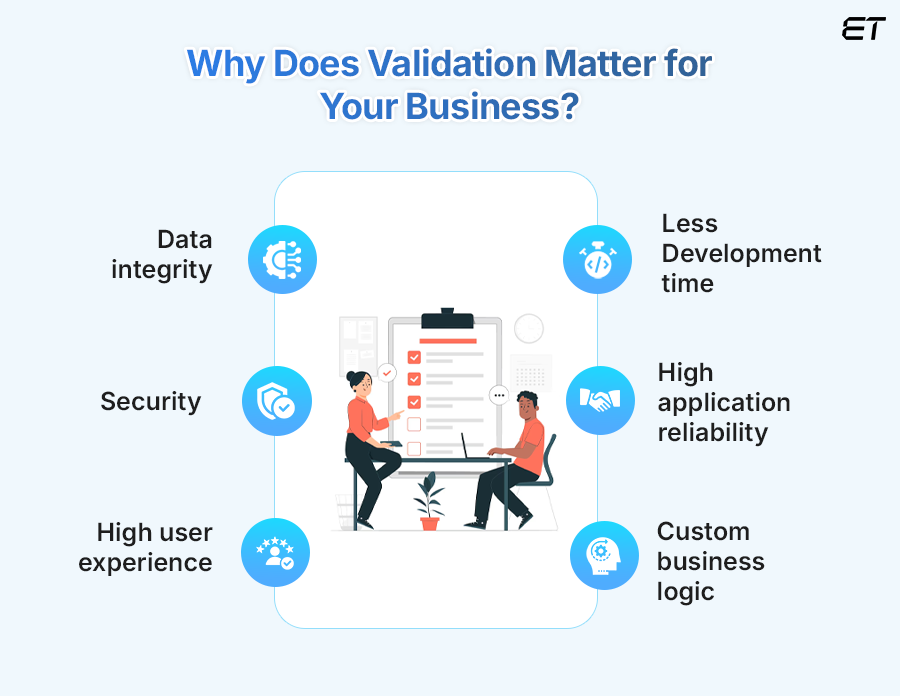
#1 Validation ensures data integrity
- It helps maintain the integrity of your data by ensuring that only the correct data types and formats enter your system.
- Customer information, product details, and transaction records are always stored and processed in the correct format.
- If the forms or user inputs are not validated properly, this can lead to inconsistencies in data, which can cause problems in your business operations, reporting, or decision-making.
#2 Enhances Security
- Its built-in validation rules provide an essential layer of security protection by ensuring that all user inputs meet predefined criteria.
- It minimizes the risk of data breaches and unauthorized access.
- This acts as a great shield, especially if you’re dealing with sensitive user data, such as using or storing their personal or financial information.
- If you do not keep this in check, you might encourage your business to engage in a data breach that can have severe legal and financial consequences.
#3 Improves user experience
- Laravel validation helps prevent errors and ensures that users submit forms or data in the correct format from the beginning.
- It will prompt users to correct mistakes like entering invalid email formats or incomplete addresses if enabled.
- This reduces users’ frustration and increases their chances of completing the desired actions, such as filling out a form, making a purchase, or signing up for a service.
#4 Reduces development time
- With Laravel validation, you can enforce complex validation rules quickly and easily without writing extensive custom code.
- It speeds up your application’s development process and makes it easier for you to maintain it in the long run.
- It provides your business with a competitive edge. It assists your business in faster application development, which translates to lower costs and quicker time to market your product and service.
#5 Increases application reliability
- The Laravel validation system ensures that only correct, valid data enters your system. This reduces the chances of bugs, errors, or system crashes caused by invalid inputs.
- By ensuring that your application behaves consistently under different conditions, you can build a more reliable, scalable product that your users can trust.
#6 Supports custom business logic with Form Request Class
- Laravel validation system is highly customizable, allowing you to create validation rules that align with your specific operational needs.
- From validating unique identifiers to enforcing business-specific rules for product categories to checking custom data formats, it offers the flexibility to ensure your validation logic fits perfectly with your business operations.
Experience the Laravel expertise that drives results. See why businesses choose us to power their web apps!
Best Practices for Implementing Laravel Validation and Handling Validation Errors
When implementing Laravel validation in your application, follow the best practices to enhance the security and efficiency of your data handling. Validation of incoming requests occurs before the controller method executes, allowing developers to keep their controller methods clean and focused on handling business logic rather than validation processes.
1. Keep validation logic separate to keep your codebase organized, clean, modular, and easier to maintain. If the authorized method returns false, the request will be aborted with a 403 Forbidden response, protecting resources by ensuring only authorized users can access or modify them.
2. Leverage built-in validation rules whenever possible to avoid reinventing the wheel and ensure a more efficient validation process.
3. Use custom rules to handle complex data logic that goes beyond the default rule set.
4. Implement real-time validation with AJAX to reduce frustration and improve the overall user experience.
5. Always sanitize your data to prevent malicious input from causing security issues.
6. Add conditional validation to make your forms more dynamic and flexible.
These practices will streamline your code, improve user experience, protect your system from potential vulnerabilities, and make it easier to manage and scale your project.
Wrapping Up!
As we wrap up, we hope this blog helps you understand data handling through Laravel validation. Whether you’re handling basic form validation or complex ones, the Laravel validation system offers you the flexibility, reliability, and power to meet your business needs.
Make validation an integral part of your application if you want to provide a better user experience and safeguard their data from potential risks. If you have any queries or doubts, please feel free to reach out to our experts and seek their advice for a better solution.
Frequently Asked Questions
1. What is validation in Laravel?
Validation in Laravel ensures that the data entered by your users meets specific criteria before processing it in your system. It helps in preventing incorrect or malicious data being stored, ensuring security and data integrity in your application.
2. Where are the validation rules in Laravel?
Laravel validation rules are mainly defined within controller methods or Form Request classes. These rules specify the criteria data must meet, like required fields, specific formats, or character length restrictions.
3. How to validate a file in Laravel?
To validate a file in Laravel, you can use the validate() method in your controller with specific rules like file, mimes, or max to ensure the file type and size are acceptable.
4. Can I create custom validation rules in Laravel?
Yes, you can create custom validation rules by using the Rule facade or by creating a custom class rule. This helps you define more complex or project-specific validations.
5. How can I validate arrays in Laravel?
To validate an array in Laravel, you need to specify the array field in the validate() method.
Excellence-driven professional with 15+ years of experience in increasing productivity, and revenue, while effectively managing products of all sizes. He has worked for international clients in the US, UK, and Singapore and local companies in various domains. With excellent attention to detail and a methodical approach to execution, he is an expert in bringing projects to a successful stage. He follows James Humes’s famous saying- “The art of communication is the language of leadership.”
